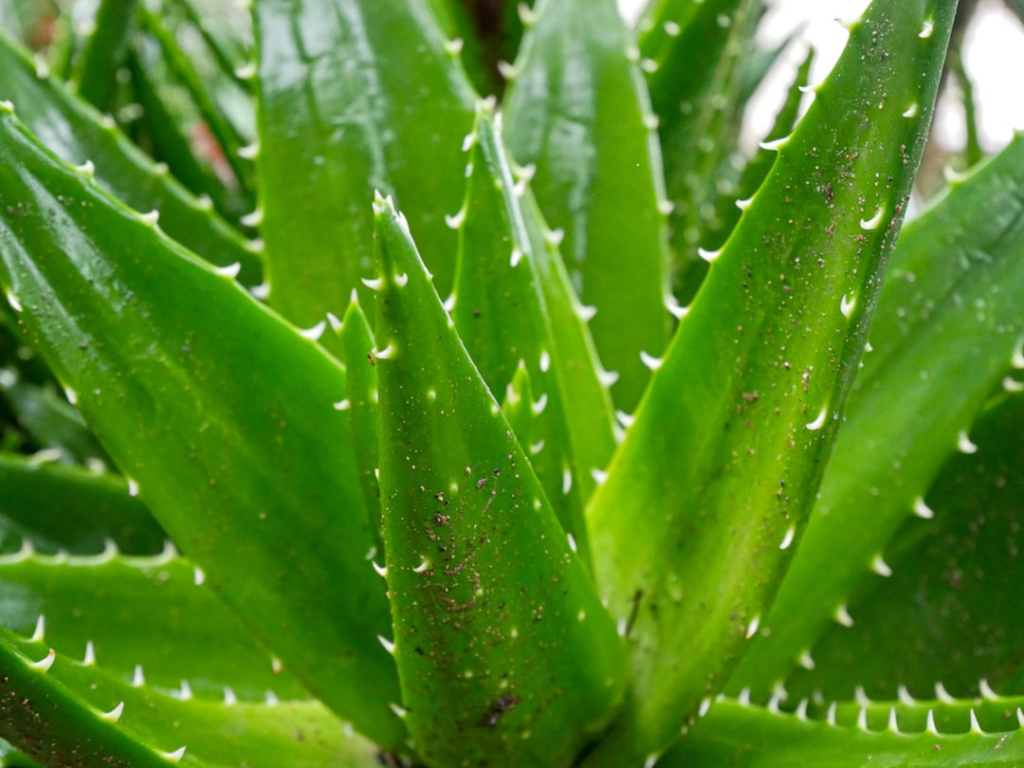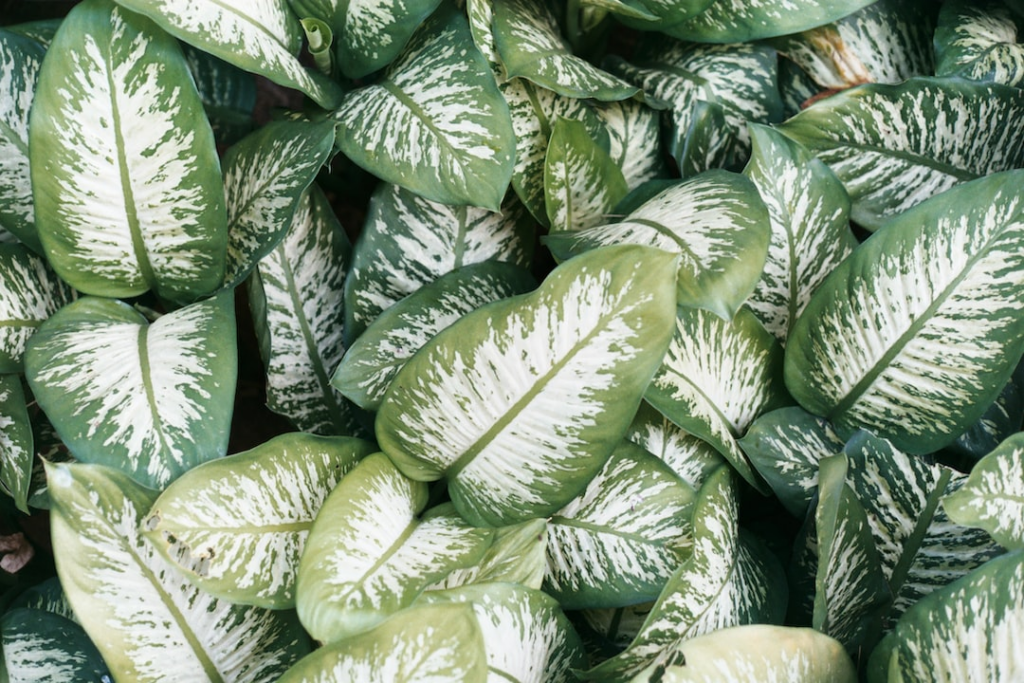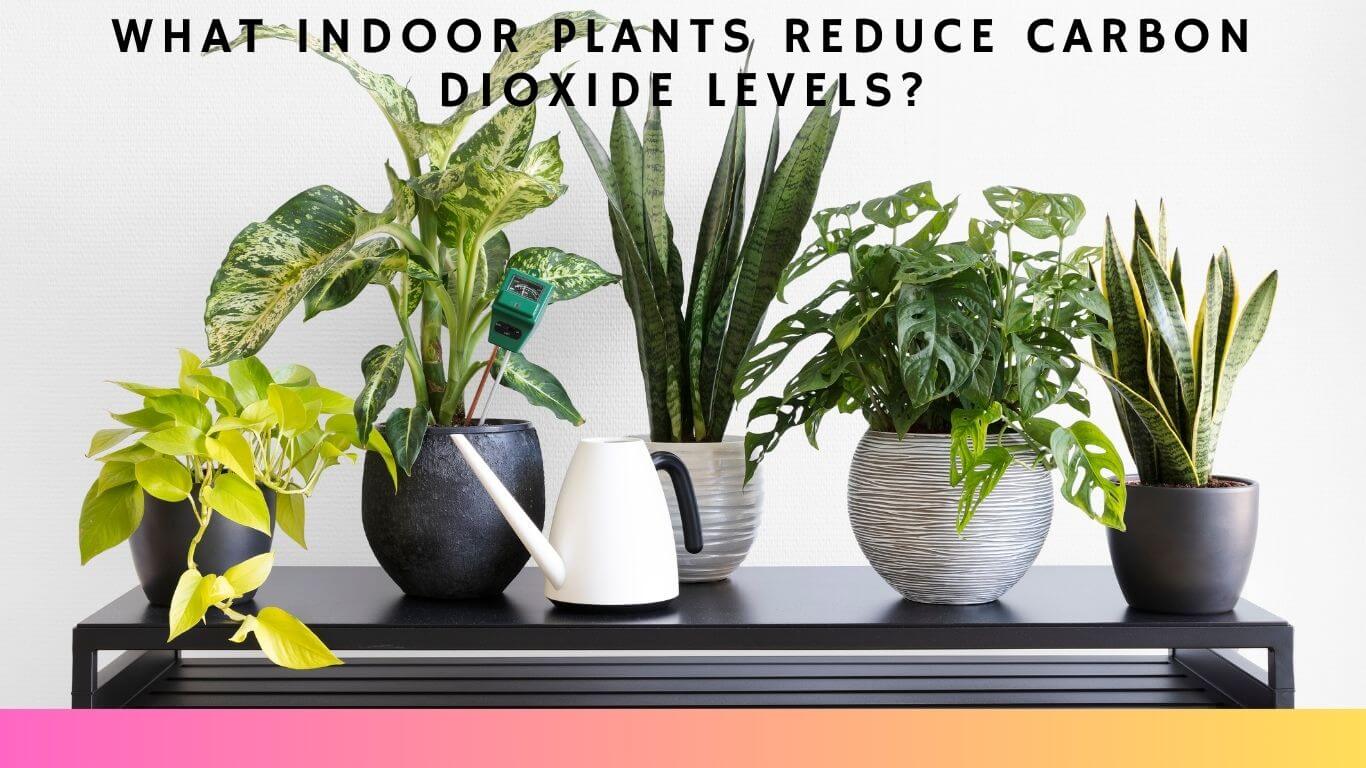With the growing concern about climate change and its impact on our planet, finding ways to reduce carbon dioxide emissions has become a top priority. While many efforts are focused on outdoor environments, it is important not to overlook the potential of indoor spaces in contributing to this cause.
Indoor plants have been recognized for their ability to absorb carbon dioxide and release oxygen, helping to purify the air we breathe. In this article, we will delve into the world of indoor plants and discover which ones are particularly effective in reducing carbon dioxide levels, making them a valuable addition to any home or office.
Whether you are looking to purify the air in your home or create a more eco-friendly living space, incorporating specific indoor plants can help reduce carbon dioxide levels and contribute to a greener and healthier indoor environment.
Snake Plant

Snake plants, scientifically known as Sansevieria trifasciata, have numerous benefits when it comes to improving indoor air quality. These plants are natural air purifiers, capable of removing toxins such as formaldehyde and benzene from the air. This can greatly enhance the overall air quality in your home or office, creating a healthier and more comfortable environment for you and your family.
One of the great advantages of snake plants is their low-maintenance nature. They’re incredibly resilient and can thrive in a variety of lighting conditions, from bright direct sunlight to low-light areas. This makes them an ideal choice for those who may not have a green thumb or have limited time for plant care. Snake plants are also drought-tolerant, meaning they can survive with infrequent watering.
Not only do snake plants contribute to improved air quality, but they can also enhance the aesthetic of your indoor space. With their tall, upright leaves and striking variegated patterns, snake plants add a touch of elegance and beauty to any room. They can be placed in pots or even used as decorative elements in terrariums or hanging baskets.
Peace Lily

You can improve indoor air quality by placing a Peace Lily in your space. Peace lilies (Spathiphyllum) aren’t only aesthetically pleasing, but they also have several benefits for your indoor environment. These plants are known for their ability to remove harmful toxins like formaldehyde, benzene, and trichloroethylene from the air, making them an excellent choice for improving air quality in your home or office.
Caring for peace lilies is relatively easy. They thrive in medium to low light conditions, making them suitable for various indoor spaces. It’s important to water them regularly, keeping the soil moist but not overly saturated. Peace lilies prefer high humidity, so misting the leaves or placing the pot on a tray filled with water and pebbles can help maintain the ideal moisture level.
If you want to propagate peace lilies, you can do so by dividing the plant during its dormant period. Gently separate the root ball into smaller sections, ensuring each division has a healthy root system and a few leaves. Plant the divisions in separate pots and provide them with the same care as mature peace lilies.
Common pests and diseases that can affect peace lilies include spider mites, mealybugs, and root rot. Regularly inspect the leaves for signs of infestation or discoloration. To prevent these issues, keep the leaves clean by wiping them with a damp cloth and avoiding overwatering.
Peace lilies aren’t only functional but also make beautiful additions to your indoor decor. They can be displayed in various creative ways, such as hanging baskets, terrariums, or centerpiece arrangements. Their lush green foliage and elegant white flowers add a touch of serenity and tranquility to any space.
In different cultures, peace lilies hold symbolic meanings. They’re often associated with purity, innocence, and renewal. In Feng Shui, peace lilies are believed to bring harmony and balance to the home. In some cultures, peace lilies are also seen as a symbol of sympathy and are commonly used in funeral arrangements.
Bamboo Palm

One effective indoor plant for reducing carbon dioxide levels is the Bamboo Palm. This tropical plant, also known as Chamaedorea seifrizii, not only adds a touch of elegance to your home decor but also plays a vital role in improving indoor air quality. Here are some benefits of the Bamboo Palm for your indoor environment:
- Releases oxygen: Like all plants, the Bamboo Palm absorbs carbon dioxide and releases oxygen during photosynthesis. This natural process helps to increase oxygen levels in your home, providing a fresher and healthier atmosphere.
- Removes toxins: The Bamboo Palm is known for its ability to filter harmful pollutants from the air, such as formaldehyde, benzene, and trichloroethylene. By incorporating this plant into your living space, you can reduce the presence of these toxins, promoting a cleaner environment.
- Increases humidity: This plant has the added benefit of releasing moisture into the air through transpiration. By increasing humidity levels, the Bamboo Palm can help alleviate dryness and improve respiratory comfort.
To care for a Bamboo Palm, ensure it receives bright, indirect light and keep the soil evenly moist. Avoid overwatering, as this can lead to root rot. As for incorporating this plant into your home decor, the Bamboo Palm’s graceful, arching fronds make it an ideal choice for adding a touch of greenery to any room.
When it comes to reducing indoor carbon dioxide levels, the Bamboo Palm is a great choice. Comparing it with other indoor plants for air purification, the Bamboo Palm stands out for its ability to not only remove toxins but also increase oxygen levels and humidity. By welcoming this plant into your home, you can enjoy its many benefits while creating a healthier and more inviting living space.
Spider Plant

The Spider Plant is a popular choice for reducing carbon dioxide levels indoors. This versatile plant not only adds beauty to your home but also helps improve the indoor air quality. One of the major benefits of having spider plants in your home is their ability to naturally purify the air. They absorb carbon dioxide and release oxygen during photosynthesis, helping to create a healthier environment for you and your family.
Caring for spider plants is relatively easy, making them a great option for both experienced gardeners and beginners. They prefer bright, indirect light and should be watered regularly, allowing the soil to dry out slightly between waterings. Spider plants are also known for their ability to thrive in a variety of conditions, making them a resilient choice for any home.
In addition to their air-purifying qualities, spider plants can also be creatively displayed in your home. Consider hanging them in macrame planters or placing them on shelves to add a touch of greenery to any room. Their long, arching leaves make for an eye-catching display, and their ability to tolerate low light levels makes them suitable for almost any space.
Aloe Vera

Continuing with the discussion on plants that reduce carbon dioxide levels indoors, another effective option is the aloe vera plant. Aloe vera isn’t only a popular houseplant, but it also offers numerous benefits and uses beyond its ability to decrease carbon dioxide levels.
Here are some key points to consider when incorporating aloe vera into your indoor space:
- Aloe vera benefits and uses beyond reducing carbon dioxide levels:
- Aloe vera gel has soothing properties and can be used to treat sunburns, minor cuts, and skin irritations.
- Aloe vera juice is known for its potential digestive benefits and can help with issues like constipation and heartburn.
- Aloe vera plants can improve indoor air quality by filtering out harmful toxins such as formaldehyde and benzene.
- The best indoor conditions for growing aloe vera plants:
- Aloe vera thrives in bright, indirect sunlight, so place it near a window that receives ample sunlight throughout the day.
- Ensure that the temperature remains between 55 to 80 degrees Fahrenheit (13 to 27 degrees Celsius) for optimal growth.
- Use a well-draining potting mix and water the plant deeply but infrequently, allowing the soil to dry out between waterings.
- How to care for and propagate aloe vera plants indoors:
- Aloe vera is a low-maintenance plant that requires minimal watering and can tolerate some neglect.
- Propagate aloe vera by removing and replanting the offshoots, also known as ‘pups,’ that grow from the base of the plant.
- Provide occasional fertilization with a balanced houseplant fertilizer during the growing season to promote healthy growth.
In addition to its carbon dioxide-reducing properties and ease of care, aloe vera can be a natural remedy for common ailments and a valuable addition to your skincare routine. By incorporating aloe vera gel or juice into your daily routine, you can enjoy the benefits of healthy and glowing skin.
English Ivy

English Ivy, scientifically known as Hedera helix, isn’t only an aesthetically pleasing addition to your home or office, but it also offers numerous benefits for air purification.
English Ivy is one of the best indoor plants for air purification. It has the ability to remove harmful airborne toxins such as formaldehyde, benzene, and xylene, making it a great choice for improving indoor air quality. Additionally, this plant is known for its ability to reduce mold and airborne allergens, making it particularly beneficial for those with respiratory issues or allergies.
Caring for English Ivy is relatively easy. It thrives in bright, indirect light and prefers cooler temperatures. Regular watering is essential, but be careful not to overwater as it can lead to root rot. To maintain its lush appearance, occasional misting is recommended to increase humidity levels.
Propagation of English Ivy is straightforward. Simply cut a healthy stem with a few leaves and place it in a jar of water. Once roots have formed, transfer the cutting into a pot with well-draining soil. Remember to keep the soil slightly moist but not waterlogged.
Incorporating English Ivy into your indoor space not only adds a touch of nature but also improves air quality. By following these tips for care and propagation, you can enjoy the benefits of this versatile plant while creating a healthier environment for yourself and your loved ones.
Areca Palm

The Areca Palm, also known as Dypsis lutescens, isn’t only a beautiful addition to your interior design, but it also offers numerous advantages as an indoor plant option.
Benefits of having an Areca Palm in your indoor space:
- The Areca Palm acts as a natural air purifier, filtering out harmful toxins and releasing oxygen, creating a cleaner and healthier environment for you and your family.
- This plant has aesthetic appeal, with its feathery and arching fronds adding a touch of elegance and tropical vibes to your home decor.
- The Areca Palm requires minimal maintenance, making it a convenient choice for those who desire the benefits of indoor plants without the hassle of high upkeep.
How to care for an Areca Palm plant:
- Place the plant in a well-lit area, but avoid direct sunlight as it can scorch the leaves.
- Water the plant regularly, ensuring that the soil is moist but not waterlogged.
- Provide high humidity levels by misting the leaves or placing the pot on a tray filled with water and pebbles.
Rubber Plant

The Rubber Plant, also known as Ficus elastica, offers similar benefits to the Areca Palm in reducing carbon dioxide levels in your indoor space. This attractive and low-maintenance plant not only adds a touch of green to your home but also helps improve the air quality. The rubber plant has broad, glossy leaves that absorb carbon dioxide and release oxygen through photosynthesis. Additionally, it acts as a natural air purifier by filtering out harmful toxins such as formaldehyde and benzene from the air.
To care for a rubber plant, place it in a well-lit area away from direct sunlight to prevent leaf burn. Maintain a moderate temperature between 60-75°F (15-24°C) and water the plant when the top inch of soil feels dry. Avoid overwatering as it can lead to root rot.
The following table highlights the benefits of the rubber plant in indoor environments:
| Benefits of Rubber Plant in Indoor Environments |
|---|
| Absorbs carbon dioxide and releases oxygen |
| Filters out formaldehyde and benzene |
| Adds beauty and greenery to your home |
| Low-maintenance and easy to care for |
For best placement, consider placing rubber plants in areas where you spend most of your time, such as the living room or bedroom. These plants thrive in bright, indirect light and can tolerate low light conditions as well.
If you want to propagate rubber plants, you can do so through stem cuttings. Simply take a cutting from a healthy plant, dip it in rooting hormone, and place it in a pot with well-draining soil. Keep the soil moist and within a few weeks, you will see new roots forming.
Boston Fern

You can reduce carbon dioxide levels in your indoor space by incorporating the Boston Fern, known for its ability to absorb carbon dioxide and release oxygen through photosynthesis. This popular houseplant offers numerous benefits for indoor spaces, making it a great addition to any home or office.
Here are some key points to consider:
- Benefits of Boston Fern in indoor spaces:
- The Boston Fern is highly effective at removing toxins from the air, improving air quality, and creating a healthier environment.
- Its lush green fronds add a touch of natural beauty and create a calming atmosphere in any room.
- As a non-toxic plant, it’s safe to have around children and pets.
- How to care for Boston Ferns:
- Place your Boston Fern in a bright, indirect light location to ensure optimal growth.
- Keep the soil consistently moist, but not waterlogged, by watering regularly.
- Maintain a moderate level of humidity, as the Boston Fern thrives in humid environments.
- Different varieties of Boston Ferns:
- There are several varieties of Boston Ferns available, each with its own unique appearance and characteristics. Some popular varieties include the Boston Sword Fern, the Kimberly Queen Fern, and the Dallas Fern.
Incorporating Boston Ferns into your indoor space isn’t only beneficial but also provides an opportunity for creative decoration. Consider hanging them in macrame planters, using them as a centerpiece in a terrarium, or placing them on a plant stand to create a focal point in your room. With their air-purifying properties and versatility, Boston Ferns are an excellent choice for both beginners and experienced plant enthusiasts.
Golden Pothos
To continue improving the air quality in your indoor space, another plant that effectively reduces carbon dioxide levels is the Golden Pothos, known for its ability to absorb carbon dioxide and release oxygen through photosynthesis.
The Golden Pothos, scientifically known as Epipremnum aureum, is a popular choice for indoor plant enthusiasts due to its numerous benefits for indoor air quality.
One of the main benefits of Golden Pothos is its ability to remove harmful toxins from the air, such as formaldehyde, benzene, and trichloroethylene. These toxins are commonly found in household products and can have detrimental effects on our health. By having Golden Pothos in your indoor space, you can effectively purify the air and create a healthier living environment.
Caring for Golden Pothos is relatively easy, making it an ideal choice for beginners. It thrives in moderate to low light conditions and requires minimal watering. It can be propagated easily by taking stem cuttings and placing them in water until roots develop. This makes it a great plant option for those looking to create a greener home.
In addition to its air-purifying qualities, Golden Pothos can also be a stylish addition to your living space. It can be displayed in various creative ways, such as hanging baskets, wall-mounted planters, or even as a trailing plant on shelves. Its vibrant green leaves can add a touch of nature and beauty to any room.
The Golden Pothos has a rich history and symbolism in different cultures. In Chinese culture, it’s considered a symbol of good luck and prosperity, often displayed in homes and businesses. In Feng Shui, it’s believed to bring positive energy and harmony to the space.
Philodendron

Philodendron plants have numerous benefits for indoor air quality. They’re known for their ability to remove toxins such as formaldehyde, benzene, and trichloroethylene from the air, creating a healthier environment for you to breathe. Philodendrons release oxygen, which contributes to a more oxygen-rich atmosphere in your home or office.
When caring for philodendron plants, there are a few tips to keep in mind. They prefer bright, indirect light, so placing them near a window is ideal. It’s also important to water them regularly, allowing the soil to dry out slightly between waterings. Philodendrons are relatively easy to propagate, and you can do so by taking stem cuttings and placing them in water or a well-draining potting mix.
In terms of the best indoor locations for philodendron plants, they thrive in areas with high humidity, such as bathrooms or kitchens. However, they can adapt to a variety of environments as long as they receive adequate light and water.
There are creative ways to display philodendron plants. You can hang them on macrame plant hangers, place them on shelves, or grow them on a moss pole for added visual interest.
Chinese Evergreen

Chinese Evergreen is another indoor plant that effectively reduces carbon dioxide levels in your space. This beautiful and versatile plant not only adds a touch of greenery to your home decor but also provides a range of benefits.
One of the main benefits of having Chinese Evergreen as an indoor plant is its ability to improve indoor air quality. It removes toxins such as formaldehyde and benzene from the air, making it a great choice for those with allergies or respiratory issues. Chinese Evergreen releases oxygen during photosynthesis, helping to increase oxygen levels in your home.
Caring for Chinese Evergreen is relatively easy, making it a perfect choice for beginners. It thrives in low to moderate light conditions and prefers well-draining soil. Water the plant when the top inch of soil feels dry, but be careful not to overwater as it can lead to root rot.
Chinese Evergreen comes in a variety of different varieties, each with its own unique characteristics. Some popular varieties include the Aglaonema Silver Bay, with its striking silver and green leaves, and the Aglaonema Red Siam, which features vibrant red and green foliage.
Incorporating Chinese Evergreen into your home decor is a great way to add a touch of greenery and improve indoor air quality. Whether you place it in a pot on a shelf or use it as a centerpiece on your dining table, this versatile plant is sure to enhance the aesthetics of your space.
Dracaena

Dracaena is a popular indoor plant that effectively reduces carbon dioxide levels in your space. With its ability to convert CO2 into oxygen through photosynthesis, dracaena plays a crucial role in improving indoor air quality.
Here are some key benefits of having dracaena in your home:
- Dracaena acts as an effective natural air purifier, absorbing harmful pollutants such as formaldehyde, benzene, and trichloroethylene. This not only helps reduce CO2 levels but also creates a healthier environment for you and your family.
- To maximize the CO2 reduction benefits of dracaena, it’s important to provide proper care. This includes placing the plant in a well-lit area, watering it regularly, and ensuring proper drainage to prevent waterlogging.
- Certain dracaena varieties are particularly effective in reducing carbon dioxide levels. The Dracaena marginata and Dracaena fragrans varieties are known for their ability to absorb large amounts of CO2, making them ideal choices for improving indoor air quality.
ZZ Plant

To continue improving indoor air quality and reducing carbon dioxide levels, another effective indoor plant is the ZZ Plant. The ZZ Plant, also known as Zamioculcas zamiifolia, is a popular choice for indoor gardening due to its ability to filter and purify the air.
One of the benefits of ZZ plants for indoor air quality is their ability to remove toxins such as formaldehyde, benzene, and xylene from the air. These toxins are commonly found in household products, making the ZZ Plant a valuable addition to any indoor space.
When caring for ZZ plants indoors, it’s important to provide them with the right conditions. They thrive in low to medium light conditions, making them perfect for areas with minimal sunlight. Overwatering can be detrimental to ZZ plants, so it’s crucial to let the soil dry out between waterings. Additionally, ZZ plants prefer well-draining soil and should be fertilized sparingly.
The best placement for ZZ plants in your home is in areas with indirect sunlight, such as living rooms, bedrooms, or offices. They can also be placed in bathrooms as they tolerate low-light conditions well. ZZ plants are great for adding greenery and improving air quality in any room.
If you want to propagate ZZ plants, it’s best to do so through leaf cuttings or division. Leaf cuttings can be taken and placed in a moist potting mix until they develop roots. Division involves separating the plant into smaller sections and replanting them individually.
Common problems with ZZ plants include overwatering, which can lead to root rot, and pest infestations. To prevent overwatering, allow the soil to dry out between waterings. In the case of pests, such as spider mites or mealybugs, regular inspections and the use of insecticidal soap can help keep them at bay.
Pothos
Continuing with our exploration of indoor plants that reduce carbon dioxide levels, let’s now delve into the benefits of Pothos. Pothos plants, scientifically known as Epipremnum aureum, offer numerous advantages when it comes to purifying the air in your home. Here are some key benefits of having Pothos plants in your home:
- Pothos plants are highly effective in removing harmful toxins such as formaldehyde, benzene, and xylene from the air, creating a healthier environment for you and your family.
- These plants are low-maintenance and can thrive in a variety of light conditions, making them suitable for any room in your home.
- Pothos plants possess air-purifying capabilities that not only reduce carbon dioxide levels but also increase oxygen production, promoting better air quality.
Now that you understand the benefits of having Pothos plants in your home, let’s explore some tips for caring for them:
- Pothos plants prefer well-draining soil and should be watered when the top inch of soil feels dry to the touch.
- They thrive in moderate to bright indirect light, although they can tolerate low light conditions.
- Pothos plants can be easily propagated by cuttings, allowing you to expand your collection or share the joy of these plants with others.
To display your Pothos plants creatively, consider hanging them in macrame plant hangers or placing them on shelves or windowsills. Lastly, let’s address some common problems and solutions for Pothos plants:
- Yellowing leaves may indicate overwatering, so adjust your watering schedule accordingly.
- Brown tips on the leaves may be a sign of low humidity, so misting the plant or using a humidifier can help.
- If your Pothos plant becomes leggy, prune it back to encourage bushier growth.
Weeping Fig

The Weeping Fig, also known as Ficus benjamina, isn’t only a visually appealing indoor plant but also a natural air purifier that can greatly improve indoor air quality in your home or office.
One of the main benefits of the Weeping Fig is its ability to remove harmful pollutants from the air, such as formaldehyde, benzene, and trichloroethylene. These pollutants can be commonly found in household items like carpets, furniture, and cleaning products. By having a Weeping Fig in your space, you can effectively reduce the levels of these toxins, creating a healthier environment for you and your loved ones.
Caring for a Weeping Fig indoors is relatively easy. It thrives in bright, indirect light and prefers moderate humidity. It’s important to water the plant thoroughly but allow the soil to dry out slightly between waterings. Additionally, regular pruning will help maintain its desired shape and size.
In terms of aesthetic appeal, the Weeping Fig adds a touch of elegance and natural beauty to any room. Its graceful, drooping branches and glossy, dark green leaves can create a calming and soothing atmosphere, promoting a sense of peace and tranquility.
To incorporate the Weeping Fig into your interior decor for better air quality, consider placing it in areas that tend to have higher levels of pollutants, such as near windows or in rooms with new furniture. You can also place it in decorative pots or planters that complement the overall aesthetics of your space.
Devil’s Ivy

Devil’s Ivy, also known as Epipremnum aureum, isn’t only a beautiful addition to your indoor space but also has numerous benefits in improving indoor air quality.
Here are some key points to consider when incorporating Devil’s Ivy into your home:
- Devil’s Ivy as a natural air purifier: This plant has the ability to remove harmful toxins such as formaldehyde, benzene, and xylene from the air, making it a valuable asset in improving indoor air quality.
- Benefits of Devil’s Ivy in improving indoor air quality: With its large leaves and extensive foliage, Devil’s Ivy has a high transpiration rate, which means it releases a significant amount of moisture vapor into the air. This process helps to increase humidity levels and reduce the presence of airborne pollutants.
- How to care for Devil’s Ivy as an indoor plant: Devil’s Ivy thrives in bright, indirect light and requires moderate watering. It’s important to avoid overwatering as it can lead to root rot. Additionally, regular pruning will help maintain its lush appearance and prevent it from becoming too invasive.
The aesthetic appeal of Devil’s Ivy in home decor: With its trailing vines and heart-shaped leaves, Devil’s Ivy adds a touch of greenery and elegance to any indoor space. It can be displayed in hanging baskets, placed on shelves, or trained to climb walls.
Devil’s Ivy as a low-maintenance indoor plant: This plant is known for its resilience and ability to adapt to various indoor conditions. It can tolerate low light and irregular watering, making it an ideal choice for those with busy lifestyles or limited gardening experience.
Incorporating Devil’s Ivy into your home not only enhances the visual appeal of your space but also contributes to a healthier indoor environment. With its air purifying qualities, low maintenance requirements, and aesthetic charm, Devil’s Ivy is a perfect addition to any home decor scheme.
Conclusion
In conclusion, incorporating indoor plants such as the Snake Plant, Peace Lily, and Bamboo Palm can effectively reduce carbon dioxide levels in enclosed spaces.
These plants have been scientifically proven to absorb carbon dioxide through their natural processes of photosynthesis, thus improving indoor air quality.
As the adage goes, ‘Nature is the best healer,’ and these plants serve as a natural remedy for reducing carbon dioxide and promoting a healthier environment indoors.

















